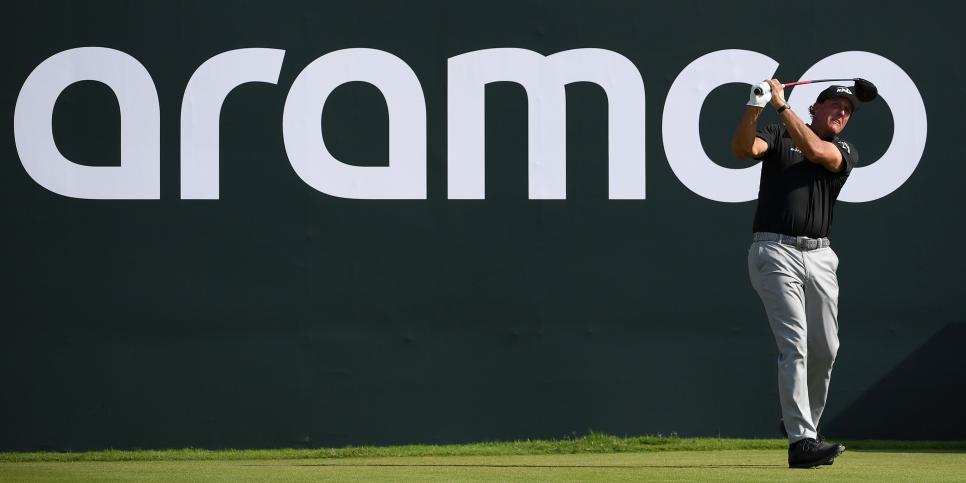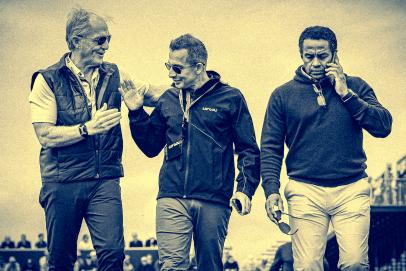Editor's Note: This article first appeared in Fire Pit Collective, a Golf Digest content partner.
This story originally appeared as the landscape of professional golf was rapidly shifting. The Premier Golf League is no longer a going concern; Saudi Arabia’s hold on the sport has gone from theoretical to very real, though the Saudi Golf League has been rebranded as LIV Golf. But the guts of this story remain deeply relevant as professional golf continues to grapple with the specter of Saudi Arabian influence.
Recent reports that the Premier Golf League is back from the dead has led to renewed rumblings that professional golf is facing fundamental reordering, fueled by Saudi Arabian money. In fact, the situation is more nuanced. The PGL is still actively trying to create a viable competitor to the PGA and European Tours but it is not staked by Saudi money, as is widely believed. “They’re not our partners, they’re now our competitors,” says a PGL investor. After the idea for the PGL was born in 2019 there were advanced discussions with Golf Saudi to underwrite the all-star new tour. A deal was never consummated and now Saudi Arabia is making its own play with the Saudi Golf League. “They 100% stole our idea,” says the PGL investor, who hails from Europe.
There are substantial differences between the two would-be tours. The Saudi Golf League is conceived as 10-12 tournaments a year, with stops in the U.S., Europe, Asia and at least a couple of splashy events in Saudi Arabia, which has a stated goal of building dozens of new golf courses and introducing a million citizens to the game over the next decade. Golf Saudi’s motivation in creating the SGL is continued reputation-laundering for the brutal regime that supports it. (Yasir Al-Rumayyan is both the chairman of Golf Saudi and the governor of the Public Investment Fund, which was established in 1971 by royal decree to provide financing for projects of strategic significance to the Saudi Arabian government.) Buying hearts and minds doesn’t come cheap; an agent for an American player in the top 10 of the World Ranking calls the Saudi offers “funny money” that could approach a guaranteed $50 million a year to marquee players.
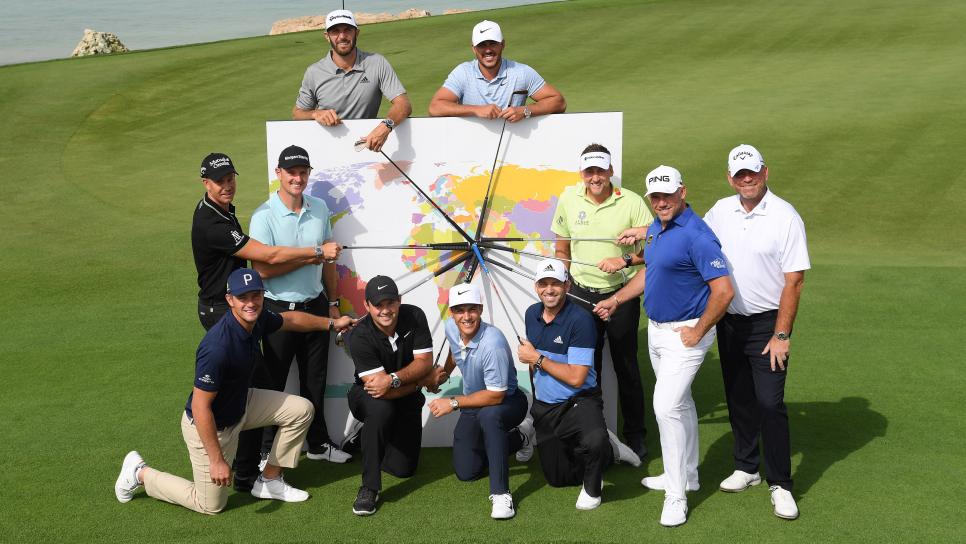
Lured by extravagant appearance fees, the game’s top players have traveled to the Saudi Invitational, guests an oppressive regime.
Ross Kinnaird
Having parted ways with the Saudis, the PGL is now staked by three dozen investors described by the insider as “guys who own existing sports franchises, high net-worth individuals who love golf and multinational corporations.” It is a mix of mostly American and European interests. The schedule would be comprised of 18 tournaments running January-October. The Tour would begin in Florida, migrate to Australia and Asia before returning to the Southeastern U.S. ahead of the Masters. Ensuing tournaments would be played Stateside through the U.S. Open, followed by a long swing through Europe and then a return to Asia, with the grand finale contested back in America. Each tournament would have 48 players vying for a purse of $20 million. (Winner’s checks would approach $4 million while last place would pay out $250K; there is no cut.) Each event would crown an individual stroke play champion but there would be a concurrent, season-long 4-man team competition that would be decided in the season finale.
Both the PGL and SGL are trying to woo the same small number of superstars while PGA Tour commissioner Jay Monahan uses the levers of power to thwart the incursions (including the specious new $40 million Player Impact Program to enrich his biggest names). It is a zero-sum game for the upstart tours, as there is not enough starpower to go around. “You have to get all of the top guys or it doesn’t work,” says the PGL investor. Competing against the seemingly endless resources of the Saudis is daunting: “In golf, it seems like everybody gets in bed with them eventually.” Indeed, Phil Mickelson, Dustin Johnson, Brooks Koepka, Bryson DeChambeau and Patrick Reed are among the big-name Americans who have made the long flight to the Saudi International, a European Tour event founded in 2019 that bestows lavish appearance fees. Approached by Al-Rumayyan himself, Jack Nicklaus is currently building his first Middle East course outside of Riyadh, which led recently to a rah-rah article in Golf Magazine, which is owned by the same banking conglomerate as the Nicklaus Companies. At the inaugural Saudi Golf Summit in 2020, Gary Player and Greg Norman were among the speakers.
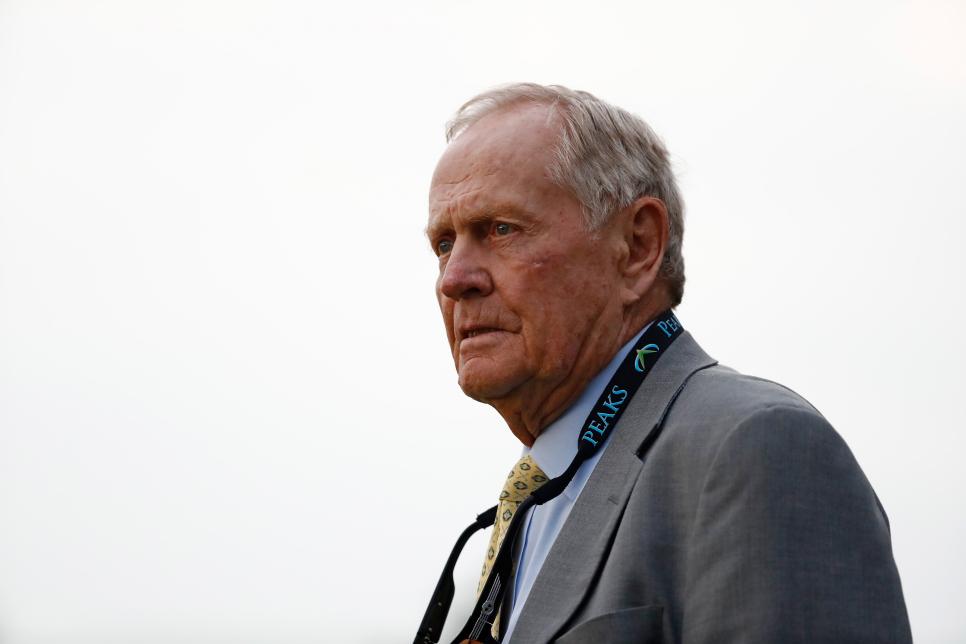
Few in the golf world are immune to Saudi money; at 81, Jack Nicklaus is building his first course in the Middle East, near Riyadh.
Sam Greenwood
As professional golf contemplates a game-changing relationship with Saudi Arabia, it is worth examining more deeply with whom the sport would be partnering. The 2018 assassination of Jamal Khashoggi, a Washington Post columnist who was a United States resident, is often cited as proof of the venality of the Saudi regime. It goes much deeper than that. Saudi Arabia was the homeland of 15 of the 19 hijackers who carried out the 9/11 attacks. In 2002, many families that lost loved ones on 9/11 signed on to the lawsuit Burnett et al v. Al Baraka Investment and Development Corporation et al. The lawsuit—initiated by the widow of Tom Burnett, who had been part of the doomed uprising against the hijackers of United 93—charges Saudi banks, charities and members of the royal family with financing Osama Bin Ladin’s and al Qaeada’s reign of terror.
A key element of the lawsuit is seeking to understand the tangled relationships between the American government and Saudi Arabia. It remains a haunting question: Why did so many of the 9/11 conspirators hail from a supposed ally? In fact, Saudi Arabia has long been a hotbed of terrorism. Khalid Sheikh Mohamed, one of the principal architects of 9/11 who is widely known as KSM, once estimated that at any given Al-Qaeda camp 70 percent of the mujahideen are Saudi. In The 9/11 Commission Report, a top al Qaeda lieutenant, Ramzi Binalshibh, said so many Saudis were chosen for the 9/11 attacks “…to send a message to the government of Saudi Arabia about its relationship with the United States.”
The U.S.-Saudi alliance began after World War II. The House of Saud was sitting on the largest oil reserves in the world, which America needed to fuel a new way of life. The Saudis had a small, aging population, shared a border with hostile Iraq and had over 1,500 miles of coastline to defend. Thus was born a crude oil-for-security pact that endures to this day. Over time, the Saudis ingratiated themselves into the elite circles of American politics and oil. They began by partnering with James Baker, George H.W. Bush’s close friend and future Chief of Staff, to build a skyscraper in Houston, netting Baker millions of dollars. Then the business relationships were leveraged into friendships. Prince Bandar bin Sultan, the Saudi ambassador to the United States from 1983-2005 and the grandson of King Abdulaziz, the founder of Saudi Arabia, played racquetball with Colin Powell, took hunting trips with George H.W. Bush and once hosted Bush’s daughter Dorothy and her children for Thanksgiving dinner, which led the First Lady to begin referring to him as “Bandar Bush.” Powell would later say Prince Bandar was like a shadow member of Bush’s Cabinet. How did this benefit the American political class? The Saudis helped facilitate all manner of dealmaking, both personal and political. As an authoritarian monarchy with none of the checks and balances of the American Constitution, the ruling family, the House of Saud, was free to do dirty work on behalf of the U.S. government. That’s why, when Bush was Vice President, Saudi Arabia funneled $32 million to the rebels battling the left-wing government of Nicaragua, helping to finance what would come to be known as the Iran-Contra Affair. (As a reward, ”President Reagan invoked emergency measures to bypass Congress and 400 Stinger missiles were secretly flown to Saudi Arabia,” according to House of Bush, House of Saud, by Craig Unger.)
As the Saudi Arabian rulers became unimaginably wealthy oil barons, one of their most favored patrons was the construction magnate Mohammed Bin Ladin, whose company Saudi Binladin Group (SBG) built castles for the royal family and rebuilt the mosques in Medina and Mecca, among the holiest sites in the Islamic world. It is said that Mohammed Bin Ladin had 50 children with more than a dozen wives; his most pious son was Osama. SBG would become business associates of George H.W. Bush by investing in the Carlyle Group, the monolithic private equity firm based in Washington, D.C. that moves billions of dollars around in what the writer Michael Lewis dubbed “access capitalism.”
In the 1980s, as the global jihadist movement was fermenting, the U.S.S.R. invaded Afghanistan. Radical Islamists from around the world made pilgrimages to the battlefield in what they considered a holy war. Osama Bin Ladin fought on the front lines and used his family’s construction company to build roads and depots for the insurgents. In battling the Soviets, Bin Ladin’s zealotry converged with President Reagan’s geopolitical interests. In a secret program overseen by Vice President Bush, the U.S. government funneled state-of-the-art weaponry to the jihadists, exporting $700 million of hardware in 1987 alone. Much of it went directly to Maktab al-Khidamat, an insurgent group co-founded by Osama Bin Ladin. It remains mind-blowing: The United States armed Bin Ladin and helped him form the precursor to al Qaeda. The Soviets’ bitter defeat in Afghanistan hastened the end of the Cold War but there were unforeseen consequences. Among the new radical Islamic leaders who emerged from the ashes was Omar Abdel-Rahman, the so-called “Blind Sheik” who masterminded the 1993 bombing of the World Trade Center that presaged the 9/11 attacks. The infrastructure built during wartime subsequently helped facilitate the heroin trade that would fund terrorism for the next three decades. And Osama Bin Ladin became a folk hero commanding a global audience and his own private army.
In 1991, with Bush now President, the U.S. launched the Gulf War against Saddam Hussein. The American military operated largely out of bases in Saudi Arabia. That “infidels” were allowed to use the holy land to kill Muslims enraged Bin Ladin and his fellow jihadists. The U.S. was once again positioned as the Great Satan, and a decade of Bin Ladin-sponsored terror began: the Blind Sheik’s bombing of the World Trade Center; the 1993 ambush and killing of 18 Army Rangers in Somalia, memorialized in Black Hawk Down; the ’95 car bombing at a military installation in Riyadh, which left five American soldiers dead; the ’98 bombing of the U.S. embassies in Tanzania and Kenya, which killed more than 200; and the 2000 assault on the USS Cole, which killed 17 U.S. Navy sailors. Unless you were directly affected, it was easy to ignore the complicated questions of why these attacks were happening. On 9/11 virtually every American was befuddled as to who was attacking us, and why. It seemed like an unprovoked onslaught that came completely out of the blue. In fact, 9/11 had been two decades in the making. It would take years for the pieces to fall into place showing how the Saudi Arabian elite played a key role in the financing on 9/11.
In 2002, Bosnian authorities raided the Sarajevo office of the Benevolence International Foundation, a multi-national Islamic charity through which millions of dollars passed annually. Among the computer files recovered were the founding documents of al Qaeda. The most significant item recovered would come to be known as “the Golden Chain.” It listed 20 wealthy Saudi donors to al Qaeda, including three billionaire bankers, a former government minister and leading merchants and industrialists.
Bringing to light these links is what compelled the 9/11 families to file Burnett et al. Saudi Arabia’s official position has long been that it was exonerated by The 9/11 Commission Report, which devoted only three pages of boilerplate to the Saudi question. Sworn affidavits related to Burnett et al paint a much different picture. “I am convinced that there was a direct line between at least some of the terrorists who carried out the September 11th attacks and the government of Saudi Arabia,” said former Senator Bob Graham, who led a 2002 Congressional probe of 9/11, the findings of which would be redacted until 2016. Senator Bob Kerrey, a member of the 9/11 Commission, said in his affidavit it was “incorrect” for the Saudis to claim they had been exonerated. “Significant questions remain unanswered,” Kerrey said. “Stated simply, the 9/11 Commission did not have the time, opportunity or resources to pursue all potentially relevant evidence on that important question, and the American public deserves a more comprehensive inquiry into the issue.”
It is the 9/11 lawsuits that have kept the pressure on both the U.S. and Saudi governments. (Burnett et al was eventually consolidated along with several other lawsuits into the overarching case In re Terrorist Attacks on September 11, 2001.) For more than a dozen years the fight for justice was hampered by a 1976 law that protected foreign governments from being sued in U.S. courts. Heavy lobbying by surviving 9/11 families finally led Congress to pass the 2016 law Justice Against Sponsors of Terrorism Act, known as JASTA. (President Obama’s veto was overridden; he claimed the law would set a troubling precedent allowing foreigners to sue the U.S. government.) The Saudi Arabian government lobbied vigorously against JASTA, even threatening widespread divestiture from American companies. But the passage of the law allowed the lawsuit to finally proceed and compelled the Obama administration to release what had become known as “28 Pages.” This was all the redacted material from the 2002 Congressional inquiry that the Bush administration had kept hidden from the American public, to say nothing of the Burnett lawyers. What were they hiding? The 28 Pages focuses largely on Omar al-Bayoumi and Shaykh al-Thumairy, Saudis who provided material support to the 9/11 hijackers as they settled in the U.S. ahead of the attacks. The report makes a persuasive case that Bayoumi is an agent of the Saudi intelligence community while Thumairy is described as a diplomat at the Saudi Consulate in Los Angeles. At long last, and despite the stonewalling of the Bush and Obama administrations, a direct link had been established between 9/11 terrorists and the Saudi Arabian government.
The lawsuits continue, as does Saudi Arabia’s influence on American politics. In October 2018, Khashoggi—a longtime critic of the House of Saud—was lured to the Saudi consulate in Istanbul, where he was killed and dismembered. American intelligence services would determine that Saudi crown prince Mohammed bin Salman approved the operation but President Trump resisted calls for formal sanctions, saying it would be “foolish” to risk the $450 billion Saudi Arabia had promised to spend and invest in the U.S. during Trump’s visit to the kingdom a year earlier. This is how the President explained his fondness for the Saudi ruling class, which dates to their purchase of many pricey condos in Trump Tower: “They pay cash.” That could be the rueful coda for America’s entire relationship with this brutally authoritarian petrocracy.
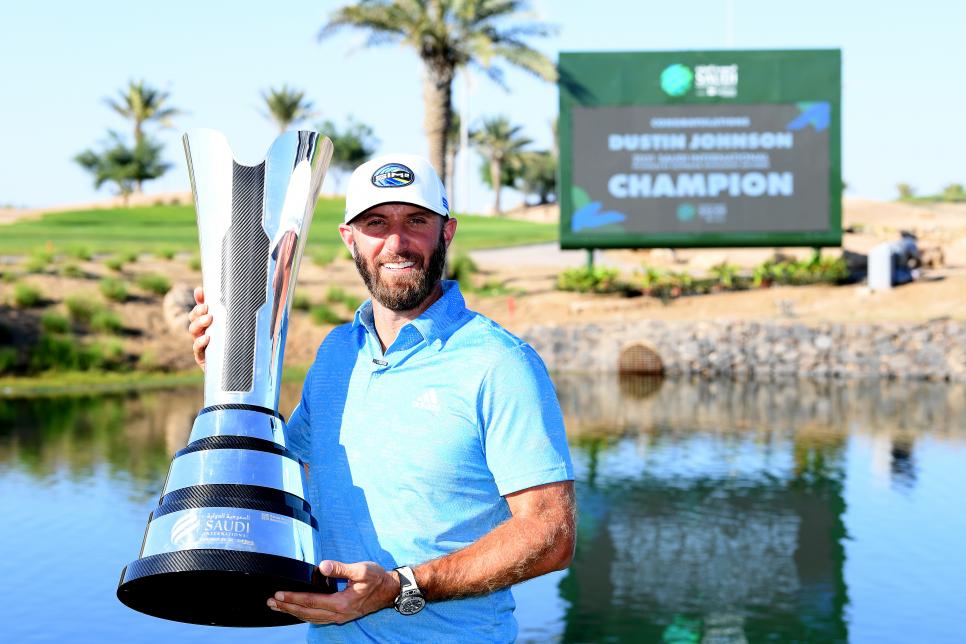
Dustin Johnson has won two of the first three Saudi Invitationals. “It’s been pretty neat to witness the growth of golf in the kingdom,” he said in a carefully-worded press release.
Ross Kinnaird
The legal system remains the only recourse for holding Saudi Arabia culpable for its role in 9/11. KSM, Saudi citizen Mustafa al-Hawsawi and three others are scheduled to finally go on trial later this year at the U.S. military prison at Guantánamo Bay for their role in orchestrating the attacks. It’s farcical that it’s taken this long but finally getting to trial will be a meaningful victory for the surviving families. Money, oil and state-sponsored secrecy allowed the Saudis to skate for nearly two decades. With justice finally looming, and more secrets likely to be revealed, the House of Saud has potentially found a new way to launder its reputation: the Saudi Golf League. The best players in the world now must ask themselves how much money will it take for them to become willing accomplices.
